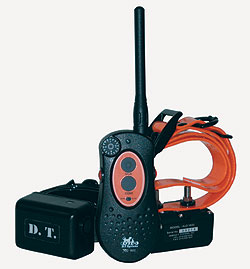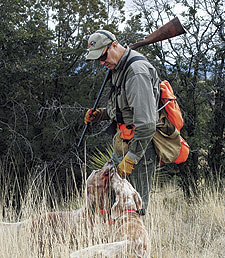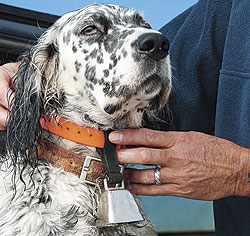In thick cover, you can't "see" your dog unless you can hear him.
By Dave Carty
When powder's bell went silent, I waited for the beep I knew would follow. Then it came: faint, muffled, and seemingly from deep within the woods. I glanced at the compass on my lanyard — I've got lost going in on points in the grouse woods more times that I can count — and then plunged headlong into the popples. And almost ran over Powder, who had locked up on a bird no more than 20 yards off the trail. That bird, which was strutting around under her nose like an irritated chicken, I missed.
 From left: Astro 220 and collar; two of the author's well worn beeper collars (note the lead decoy anchor taped to the receiver of the unit on the left); and the author's favorite bells, a No. 6 Swiss bell and a Lion Country long range bell (both available from Lion Country Supply). |
Big surprise, huh?
All of which is beside the point. Had Powder not been wearing a bell, I never would have been able to track her progress; had she not also been wearing a beeper, it would have been vastly more difficult locating her in that aspen- and pine-choked swamp.
I'm old enough to remember hunting in the sixties over my first Brittany, who would vanish into the woods, only to be rediscovered 15 minutes later when we stumbled upon him locked up on a covey of bobwhites. There's no telling how many birds he pointed that we never saw; my father, a casual bird hunter at best, was ignorant of the need for bells and on my skimpy income mowing lawns I couldn't have bought one anyway.
It took a long time for me to get with the program. I've never liked having a lot of racket around my dogs and I still don't use bells on the prairies, as several of my friends are wont to do. But in thick cover, particularly ruffed grouse, Mearns and bobwhite quail habitat, they've become an indispensible part of my canine gear bag.
Last time I checked, I had a half dozen bells in two or three different sizes, another half dozen beepers in various configurations, and a Garmin Astro 220 with four — count 'em — four tracking collars. I may be neurotic about all this, but let me make one thing clear right from the get-go: I'm neurotic about a lot of things. At least I know where my dogs are.
There was a time when nobody used beepers, and there may well have been a time when people didn't use bells. I have no idea how hunters kept track of their dogs in those halcyon days; I know of no way you can "see" your dog in cover that effectively renders him invisible if you can't hear him first.
In the grouse woods, my bell is my direct connection to my dog; my tracking collars and beepers are secondary. I can tell how far away (most of the time) my dog is, which direction she's moving, and often, whether or not she's working a bird, just by the way her bell sounds. In that cover, I'd no more consider hunting without a bell on my dog than I would leave my truck without a compass or a GPS in my vest.
Today, my rusting and battle-scarred cowbells are synonymous with aspen trees, side-by-sides, and pointing dogs. I can pick up one of my dog's bells during a scorching July afternoon, give it a ring, and find myself at once in the cool, damp October woods, its dulcet melody affirmation that I'm exactly where I'm supposed to be.
I have none of these warm, fuzzy feelings about beeper collars. If bells were designed by artists with an eye for symmetry and an ear for music, beeper collars were designed by tone-deaf accountants to solve an engineering problem: how to find your dog after he goes on point.
 Beeper collars are invaluable when hunting any cover where dogs like these orange belton English setters might be hard to see. |
There's nothing pleasant about the way they sound, and, unlike bells, they have batteries that die precisely when you're five miles from your car, where you keep the spare batteries you forgot to put in your vest. But for those of us who have dogs that do more than putter around at our feet, they're invaluable. Beepers and big-running dogs are an incongruous but perfect fit.
Nowhere are they more helpful than in the wide-open country chukars and Huns live in. There's nothing quite as impressive as standing on a ridgeline in eastern Oregon and staring at a 360-degree panorama of publicly-owned chukar habitat. As far as you can see is nothing but cheat grass, cliffs and rocks, with not a tree in sight.
It is hard to imagine, you might well think, how you could ever lose a dog in that kind of cover. But your thinking would be in for a very rude reality check.
Even close-ranging dogs tend to fan out in open country. A 100-yard Brittany may stretch out to 200 yards in a Montana wheatfield; a 300-yard pointer may kick up his heels and punch out to 500 yards in the hills of eastern Oregon or southern Idaho. The problem is that none of this country is flat. And all those folds and coulees are where your dog is going to find birds.
But a beeper's obnoxious buzz can cut across hundreds of yards of prairie, even when the wind is in the wrong direction. I've become so attuned to listening for the beep of a dog on point that I can almost sense when a dog is making game. Then I walk in that direction, until, sure enough, I hear an ever so faint beep.
It grows louder as I approach, until eventually I spy my dog, on point and waiting, a hundred yards up the side of a ridge.
Still, despite their advantages, they've never caught on with a substantial portion of the bird-hunting public. So let me dispel some myths.
First of all, beepers don't spook birds. My dogs have pointed half the species of gamebirds in North American and I've yet to see any that seemed put off by the sound of a beeper, including super-spooky grouse and pheasants.
Nor do they have to be turned on constantly. I long ago gave up running my dog's beepers on the continuous mode; listening to that racket all day was more than I could take.
Instead, I put my beepers on point-only mode, an option on every modern beeper collar I know of.
When the dog runs the beeper is silent; when he stops it starts beeping. Neither setting works perfectly. Sometimes my beeper sounds off when my dog is moving slowly; other times it's silent when she's on poin
t.
I've learned to allow for a certain amount of slop in operating efficiency. Instead of charging after the sound when I hear a single beep, now I usually wait until I've heard the beep two or three times. If the dog's got a bird, she'll hold at least that long and if not she'll move on, saving me a trip in. As far as it goes, it's a pretty good system.
I do have reservations about the decibels these things crank out, however. I once made the mistake of setting a beeper off under my ear, to see how it would sound to a dog. My ears rang for the next 10 minutes.
These things are loud! But when I held the unit above my head, the sound was entirely manageable. That's given me all kinds of incentive to protect my dog's hearing by making sure the speaker stays positioned on top of her neck.
That's not always easy to do, particularly if you run 37-pound, pencil-necked geeks like my two setters. About the only thing I've found that corrects a side-slipping beeper collar is to add enough weight on the collar below the dog's neck to counterbalance the speaker (or accessory beeper) on top. I finally settled on using the long, thin strips of lead sold as decoy anchors, which I mold and tape to the collar or an e-collar receiver below. It's not a perfect solution, but then, it's not a perfect world.
 Most middle-aged hunters have some degree of hearing loss, and deeper-toned bells are more easily heard than those with higher pitch. |
Both beepers and bells vary widely in tone. After listening to dozens of tones over the years, my recommendation is to get the deepest tone you can find.
A few years ago, my lanky friend John Palmer and I were cruising back from a successful hunt chasing Huns, when my Brittany, Powder, who had been meandering around in front of us, slammed into a point. Powder was off to my side and John didn't notice her.
When her beeper started sounding off, I waved at him, trying to get him to walk in on the point. But John, it seemed, wanted nothing to do with her.
Palmer's a committed anglophile, and his obvious disdain for my dog's point was beginning to irritate me. I could certainly understand his fondness for English side-by-sides and English setters--I love English setters, for Pete's sake--but refusing to go in on a pointing Brittany was taking it a bit too far. I finally gave in and walked up the birds myself.
Turns out he'd never heard Powder's beeper, never seen me wave.
Palmer's former job as a cop required him to teach machine-gun handling, and in the process he lost the part of his hearing that registers high tones.
Shrill beepers and small bells are simply beyond his ability to hear; he depends on his friends to tell him when their dogs are on point. Luckily for him, he's been able to locate a deep-toned beeper for his own dogs.
I am approaching old age like a cat approaching a bath, but many of my hunting buddies are even more geezer-like than I am and hearing problems of the sort Palmer suffers are by no means uncommon.
My hearing, so far, is holding up better than the rest of me. Even so, the deep tone of a No. 6 Swiss cowbell is far easier for me to hear than the tinkle of a bell half its size. Incidentally, running two dogs with slightly different sized bells makes it easier to tell them apart, even when you can't see them.
In 10 years (or less), most of the foregoing discussion on bells and beepers may seem like ancient history. The reason is the new Astro 220 GPS dog collar, which I've been using now for two seasons.
I'm not a tech junkie. I've been writing on computers for 20 years and I still hate them. I intensely dislike working on cars, programming video cameras and digital stereos, or whatever the hell they're referred to these days; and I can barely make my automatic coffee maker work.
But I love my Astro.
With my Astro in hand, I know where my dog is, where he's going, how far away he is, and whether he's on point, sitting, or treeing a coon. (Okay, the treeing part is a bit of overkill, but it's one of the functions I haven't figured out how to turn off.)
These days, I strap my GPS collar right behind my dog's e-collar, which is then attached to an accessory beeper. My poor dogs are running out of head space. The solution, of course, is simple: engineer a dog with a longer neck.
Maybe that's something those accountants at the beeper-collar companies can work on.






